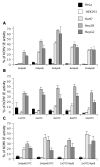Expression liver-directed genes by employing synthetic transcriptional control units
- PMID: 16149135
- PMCID: PMC4622798
- DOI: 10.3748/wjg.v11.i34.5295
Expression liver-directed genes by employing synthetic transcriptional control units
Abstract
Aim: To generate and characterize the synthetic transcriptional control units for transcriptional targeting of the liver, thereby compensating for the lack of specificity of currently available gene therapeutic vector systems.
Methods: Synthetic transcriptional control unit constructs were generated and analyzed for transcriptional activities in different cell types by FACS quantification, semi-quantitative RT-PCR, and Western blotting.
Results: A new bifunctionally-enhanced green fluorescent protein (EGFP)/neo(r) fusion gene cassette was generated, and could flexibly be used both for transcript quantification and for selection of stable cell clones. Then, numerous synthetic transcriptional control units consisting of a minimal promoter linked to "naturally" derived composite enhancer elements from liver-specific expressed genes or binding sites of liver-specific transcription factors were inserted upstream of this reporter cassette. Following liposome-mediated transfection, EGFP reporter protein quantification by FACS analysis identified constructs encoding multimerized composite elements of the apolipoprotein B100 (ApoB) promoter or the ornithin transcarbamoylase (OTC) enhancer to exhibit maximum transcriptional activities in liver originating cell lines, but only background levels in non-liver originating cell lines. In contrast, constructs encoding only singular binding sites of liver-specific transcription factors, namely hepatocyte nuclear factor (HNF)1, HNF3, HNF4, HNF5, or CAAT/enhancer binding protein (C/EBP) only achieved background levels of EGFP expression. Finally, both semi-quantitative RT-PCR and Western blotting analysis of Hep3B cells demonstrated maximum transcriptional activities for a multimeric 4xApoB cassette construct, which fully complied with the data obtained by initial FACS analysis.
Conclusion: Synthetic transcriptional control unit constructs not only exhibit a superb degree of structural compactness, but also provide new means for liver-directed expression of therapeutic genes.
Figures





Similar articles
-
Construction of a regulable gene therapy vector targeting for hepatocellular carcinoma.World J Gastroenterol. 2003 Apr;9(4):688-91. doi: 10.3748/wjg.v9.i4.688. World J Gastroenterol. 2003. PMID: 12679911 Free PMC article.
-
Interaction of hepatocyte nuclear factors in transcriptional regulation of tissue specific hormonal expression of human multidrug resistance-associated protein 2 (abcc2).Toxicol Appl Pharmacol. 2009 Feb 1;234(3):281-92. doi: 10.1016/j.taap.2008.10.005. Epub 2008 Oct 29. Toxicol Appl Pharmacol. 2009. PMID: 19010343
-
An efficient and safe herpes simplex virus type 1 amplicon vector for transcriptionally targeted therapy of human hepatocellular carcinomas.Mol Ther. 2007 Jun;15(6):1129-36. doi: 10.1038/sj.mt.6300165. Epub 2007 Apr 10. Mol Ther. 2007. PMID: 17426711
-
Activation of nicotinamide N-methyltransferase gene promoter by hepatocyte nuclear factor-1beta in human papillary thyroid cancer cells.Mol Endocrinol. 2005 Feb;19(2):527-39. doi: 10.1210/me.2004-0215. Epub 2004 Oct 14. Mol Endocrinol. 2005. PMID: 15486044
-
Cell-specific expression of artificial microRNAs targeting essential genes exhibit potent antitumor effect on hepatocellular carcinoma cells.Oncotarget. 2015 Mar 20;6(8):5707-19. doi: 10.18632/oncotarget.3302. Oncotarget. 2015. PMID: 25691059 Free PMC article.
Cited by
-
Optimized human factor IX expression cassettes for hepatic-directed gene therapy of hemophilia B.Front Med. 2015 Mar;9(1):90-9. doi: 10.1007/s11684-015-0390-2. Epub 2015 Feb 7. Front Med. 2015. PMID: 25663062
-
In vitro gene targeting in human hepatoblastoma.Pediatr Surg Int. 2006 Jan;22(1):16-23. doi: 10.1007/s00383-005-1573-8. Pediatr Surg Int. 2006. PMID: 16374644
-
Hepatocellular Carcinoma Is a Natural Target for Adeno-Associated Virus (AAV) 2 Vectors.Cancers (Basel). 2022 Jan 15;14(2):427. doi: 10.3390/cancers14020427. Cancers (Basel). 2022. PMID: 35053588 Free PMC article.
-
Synthetic Promoters in Gene Therapy: Design Approaches, Features and Applications.Cells. 2024 Nov 27;13(23):1963. doi: 10.3390/cells13231963. Cells. 2024. PMID: 39682712 Free PMC article. Review.
-
Optimizing vector application for gene transfer into human hepatoblastoma cells.Pediatr Surg Int. 2006 Sep;22(9):733-42. doi: 10.1007/s00383-006-1727-3. Epub 2006 Jul 29. Pediatr Surg Int. 2006. PMID: 16896819
References
-
- Xia D, Zhang MM, Yan LN. Recent advances in liver-directed gene transfer vectors. Hepatobiliary Pancreat Dis Int. 2004;3:332–336. - PubMed
-
- Shiratori Y, Kanai F, Ohashi M, Omata M. Strategy of liver-directed gene therapy: present status and future prospects. Liver. 1999;19:265. - PubMed
-
- Tenenbaum L, Lehtonen E, Monahan PE. Evaluation of risks related to the use of adeno-associated virus-based vectors. Curr Gene Ther. 2003;3:545–565. - PubMed
-
- Schagen FH, Ossevoort M, Toes RE, Hoeben RC. Immune responses against adenoviral vectors and their transgene products: a review of strategies for evasion. Crit Rev Oncol Hematol. 2004;50:51–70. - PubMed
Publication types
MeSH terms
LinkOut - more resources
Full Text Sources
Other Literature Sources
Medical
Miscellaneous

